| Revision as of 19:14, 25 May 2023 view sourceRotideypoc41352 (talk | contribs)Extended confirmed users15,928 edits →top: merged hatnotesTags: Mobile edit Mobile web edit Advanced mobile edit← Previous edit | Revision as of 17:25, 30 May 2023 view source GA-RT-22 (talk | contribs)Extended confirmed users, Pending changes reviewers17,491 edits remove inline ELNext edit → | ||
| Line 62: | Line 62: | ||
| ===Railcar=== | ===Railcar=== | ||
| Ettore Bugatti also designed a successful motorised railcar, the '']'' |
Ettore Bugatti also designed a successful motorised railcar, the '']''.<ref>{{cite magazine|author=Hearst Magazines|title=Streamlined Auto-Rail Car Used in France|magazine=Popular Mechanics|url=https://books.google.com/books?id=yt8DAAAAMBAJ&pg=PA885|date=December 1934|publisher=Hearst Magazines|page=885}}</ref> | ||
| ===Family tragedy=== | ===Family tragedy=== | ||
Revision as of 17:25, 30 May 2023
French car manufacturer, 1909 to 1963 This article is about the original company founded by Ettore Bugatti. For the present-day company, see Bugatti Automobiles. For other uses, see Bugatti (disambiguation).| A request that this article title be changed to Automobiles Ettore Bugatti is under discussion. Please do not move this article until the discussion is closed. |
| This article needs additional citations for verification. Please help improve this article by adding citations to reliable sources. Unsourced material may be challenged and removed. Find sources: "Bugatti" – news · newspapers · books · scholar · JSTOR (October 2009) (Learn how and when to remove this message) |
48°31′32″N 07°30′01″E / 48.52556°N 7.50028°E / 48.52556; 7.50028
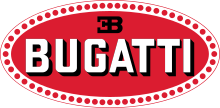 | |
| Company type | Private |
|---|---|
| Industry | Automotive |
| Founded | 1909; 116 years ago (1909) |
| Founder | Ettore Bugatti |
| Defunct | 1963; 62 years ago (1963) |
| Fate | Sold to Hispano-Suiza (1963) |
| Headquarters | Molsheim, Alsace, France |
| Key people |
|
| Products | Automobiles |
Automobiles Ettore Bugatti was a German then French manufacturer of high-performance automobiles. The company was founded in 1909 in the then-German city of Molsheim, Alsace, by the Italian-born industrial designer Ettore Bugatti. The cars were known for their design beauty and for their many race victories. Famous Bugatti automobiles include the Type 35 Grand Prix cars, the Type 41 "Royale", the Type 57 "Atlantic" and the Type 55 sports car.
The death of Ettore Bugatti in 1947 proved to be a severe blow for the marque, and the death of his son Jean Bugatti in 1939 meant that there was no successor to lead the factory. No more than about 8,000 cars were made. The company struggled financially, and it released one last model in the 1950s before eventually being purchased for its airplane parts business in 1963.
In 1987, an Italian entrepreneur bought the brand name and revived it as Bugatti Automobili SpA.
Under Ettore Bugatti
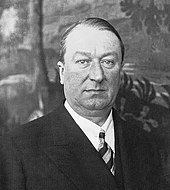
Founder Ettore Bugatti was born in Milan, Italy, and the automobile company that bears his name was founded in 1909 in Molsheim located in the Alsace region which was part of the German Empire from 1871 to 1919. The company was known both for the level of detail of its engineering in its automobiles, and for the artistic manner in which the designs were executed, given the artistic nature of Ettore's family (his father, Carlo Bugatti (1856–1940), was an important Art Nouveau furniture and jewelry designer).
World War I and its aftermath

During the war Ettore Bugatti was sent away, initially to Milan and later to Paris, but as soon as hostilities had been concluded he returned to his factory at Molsheim. Less than four months after the Versailles Treaty formalised the transfer of Alsace from Germany to France, Bugatti was able to obtain, at the last minute, a stand at the 15th Paris motor show in October 1919. He exhibited three light cars, all of them closely based on their pre-war equivalents, and each fitted with the same overhead camshaft 4-cylinder 1,368cc engine with four valves per cylinder. Smallest of the three was a "Type 13" with a racing body (constructed by Bugatti themselves) and using a chassis with a 2,000 mm (78.7 in) wheelbase. The others were a "Type 22" and a "Type 23" with wheelbases of 2,250 and 2,400 mm (88.6 and 94.5 in) respectively.
Racing successes

The company also enjoyed great success in early Grand Prix motor racing: in 1929 a privately entered Bugatti won the first ever Monaco Grand Prix. Racing success culminated with driver Jean-Pierre Wimille winning the 24 hours of Le Mans twice (in 1937 with Robert Benoist and 1939 with Pierre Veyron).
Bugatti cars were extremely successful in racing. The little Bugatti Type 10 swept the top four positions at its first race. The 1924 Bugatti Type 35 is one of the most successful racing cars. The Type 35 was developed by Bugatti with master engineer and racing driver Jean Chassagne who also drove it in the car's first ever Grand Prix in 1924 Lyon. Bugattis swept to victory in the Targa Florio for five years straight from 1925 through 1929. Louis Chiron held the most podiums in Bugatti cars, and the modern marque revival Bugatti Automobiles S.A.S. named the 1999 Bugatti 18/3 Chiron concept car in his honour. But it was the final racing success at Le Mans that is most remembered—Jean-Pierre Wimille and Pierre Veyron won the 1939 race with just one car and meagre resources.

Aeroplane racing
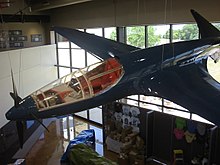
In the 1930s, Ettore Bugatti got involved in the creation of a racer airplane, hoping to beat the Germans in the Deutsch de la Meurthe prize. This would be the Bugatti 100P, which never flew. It was designed by Belgian engineer Louis de Monge who had already applied Bugatti Brescia engines in his "Type 7.5" lifting body.
Railcar
Ettore Bugatti also designed a successful motorised railcar, the Autorail Bugatti.
Family tragedy
The death of Ettore Bugatti's son, Jean Bugatti, on 11 August 1939 marked a turning point in the company's fortunes. Jean died while testing a Type 57 tank-bodied race car near the Molsheim factory.

After World War II
World War II left the Molsheim factory in ruins and the company lost control of the property. During the war, Bugatti planned a new factory at Levallois, a northwestern suburb of Paris. After the war, Bugatti designed and planned to build a series of new cars, including the Type 73 road car and Type 73C single seat racing car, but in all Bugatti built only five Type 73 cars.
Development of a 375 cc supercharged car was stopped when Ettore Bugatti died on 21 August 1947. Following Ettore Bugatti's death, the business declined further and made its last appearance as a business in its own right at a Paris Motor Show in October 1952.
After a long decline, the original incarnation of Bugatti ceased operations in 1952.

Design
Bugattis are recognized for their focus on design. Engine blocks were hand scraped to ensure that the surfaces were flat so that gaskets were not required for sealing, and many of the exposed surfaces of the engine compartment featured guilloché finishes on them. Safety wires were threaded through most fasteners in intricately laced patterns. Rather than bolt the springs to the axles as most manufacturers did, Bugatti's axles were forged such that the spring passed through an opening in the axle, a much more elegant solution requiring fewer parts. Bugatti himself described his competitor Bentley's cars as "the world's fastest lorries" for focusing on durability. According to Bugatti, "weight was the enemy".
Important models built
| Prototypes | Racing cars | Road cars |
|---|---|---|
|
|
Gallery
-
1913 Bugatti 22, 3 seat Vinet
-
 Bugatti Type 50 i
Bugatti Type 50 i
-
 1938 Type 57SC Atlantic from the Ralph Lauren collection
1938 Type 57SC Atlantic from the Ralph Lauren collection
-
 1933 Type 59 Grand Prix racer from the Ralph Lauren collection
1933 Type 59 Grand Prix racer from the Ralph Lauren collection
-
 Bugatti Type 43 Cockpit
Bugatti Type 43 Cockpit
Notable finds in the modern era
Relatives of Harold Carr found a rare 1937 Bugatti Type 57S Atalante when cataloguing the doctor's belongings after his death in 2009. Carr's Type 57S is notable because it was originally owned by British race car driver Earl Howe. Because much of the car's original equipment is intact, it can be restored without relying on replacement parts.
On 10 July 2009, a 1925 Bugatti Brescia Type 22 which had lain at the bottom of Lake Maggiore on the border of Switzerland and Italy for 75 years was recovered from the lake. The Mullin Museum in Oxnard, California bought it at auction for $351,343 at Bonham's Rétromobile sale in Paris in 2010.
Attempts at revival
The company attempted a comeback under Roland Bugatti in the mid-1950s with the mid-engined Type 251 race car. Designed with help from Gioacchino Colombo, the car failed to perform to expectations and the company's attempts at automobile production were halted.
In the 1960s, Virgil Exner designed a Bugatti as part of his "Revival Cars" project. A show version of this car was actually built by Ghia using the last Bugatti Type 101 chassis, and was shown at the 1965 Turin Motor Show. Finance was not forthcoming, and Exner then turned his attention to a revival of Stutz.
Bugatti continued manufacturing airplane parts and was sold to Hispano-Suiza, also a former auto maker turned aircraft supplier, in 1963. Snecma took over Hispano-Suiza in 1968. After acquiring Messier, Snecma merged Messier and Bugatti into Messier-Bugatti in 1977.
Modern revivals
Bugatti Automobili S.p.A. (1987–1995)

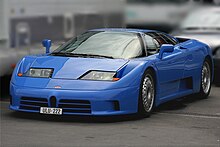
Italian entrepreneur Romano Artioli acquired the Bugatti brand in 1987, and established Bugatti Automobili S.p.A.. Artioli commissioned architect Giampaolo Benedini to design the factory which was built in Campogalliano, Modena, Italy. Construction of the plant began in 1988, alongside the development of the first model, and it was inaugurated two years later—in 1990. By 1989, the plans for the new Bugatti revival were presented by Paolo Stanzani and Marcello Gandini, designers of the Lamborghini Miura and Lamborghini Countach.
The first production vehicle was the Bugatti EB110 GT which featured a 3.5-litre, 5-valve per cylinder, quad-turbocharged 60° V12 engine, a six-speed gearbox, and four-wheel drive. Stanzani proposed an aluminium honeycomb chassis, which was used for all early prototypes. He and president Artioli clashed over engineering decisions so Stanzani left the project and Artioli sought Nicola Materazzi to replace him in June 1990. Materazzi, who had been the chief designer for the Ferrari 288 GTO and Ferrari F40 replaced the aluminium chassis with a carbon fibre one manufactured by Aerospatiale and also altered the torque distribution of the car from 40:60 to 27:73. He remained Director until late 1992. Racing car designer Mauro Forghieri served as Bugatti's technical director from 1993 through 1994. On 27 August 1993, through his holding company, ACBN Holdings S.A. of Luxembourg, Romano Artioli purchased Lotus Cars from General Motors. Plans were made to list Bugatti shares on international stock exchanges.
Bugatti presented a prototype large saloon called the EB112 in 1993.
Perhaps the most famous Bugatti EB110 owner was seven-time Formula One World Champion racing driver Michael Schumacher who purchased an EB110 in 1994. Schumacher sold his EB110, which had been repaired after a severe 1994 crash, to Modena Motorsport, a Ferrari service and race preparation garage in Germany.
By the time the EB110 came to market, the North American and European economies were in recession. Poor economic conditions forced the company to fail and operations ceased in September 1995. A model specific to the US market called the "Bugatti America" was in the preparatory stages when the company ceased operations.
Bugatti's liquidators sold Lotus Cars to Proton of Malaysia. German firm Dauer Racing purchased the EB110 licence and remaining parts stock in 1997 in order to produce five more EB110 SS vehicles. These five SS versions of the EB110 were greatly refined by Dauer. The Campogalliano factory was sold to a furniture-making company, which became defunct prior to moving in, leaving the building unoccupied. After Dauer stopped producing cars in 2011, Toscana-Motors GmbH of Germany purchased the remaining parts stock from Dauer.
Ex vice-president Jean-Marc Borel and ex-employees Federico Trombi, Gianni Sighinolfi and Nicola Materazzi established the B Engineering company and designed and built the Edonis using the chassis and engine from the Bugatti EB110 SS, but simplifying the turbocharging system and driveline (from 4WD to 2WD).
Bugatti Automobiles S.A.S. (1998–present)
Main article: Bugatti AutomobilesPre-Veyron
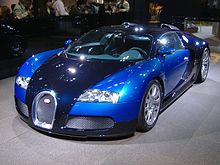
Volkswagen Group acquired the Bugatti brand in 1998. Bugatti Automobiles S.A.S. commissioned Giorgetto Giugiaro of ItalDesign to produce Bugatti Automobiles's first concept vehicle, the EB118, a coupé that debuted at the 1998 Paris Auto Show. The EB118 concept featured a 408-kilowatt (555 PS; 547 bhp), W-18 engine. After its Paris debut, the EB118 concept was shown again in 1999 at the Geneva Auto Show and the Tokyo Motor Show. Bugatti introduced its next concepts, the EB 218 at the 1999 Geneva Motor Show and the 18/3 Chiron at the 1999 Frankfurt Motor Show (IAA).
Veyron era (2005–2015)
Bugatti Automobiles S.A.S. began assembling its first regular-production vehicle, the Bugatti Veyron 16.4 (the 1001 PS super car with an 8-litre W-16 engine with four turbochargers) in September 2005 at the Bugatti Molsheim, France assembly "studio". On 23 February 2015, Bugatti sold its last Veyron Grand Sport Vitesse, which was named La Finale.
Chiron era (2016–present)

The Bugatti Chiron is a mid-engined, two-seated sports car, designed by Achim Anscheidt, developed as the successor to the Bugatti Veyron. The Chiron was first revealed at the Geneva Motor Show on March 1, 2016.
See also
- Musée National de l'Automobile de Mulhouse, home of the Schlumpf Collection of Bugatti cars
References
- ^ Wood, Jonathan (1992). Bugatti, The Man and the Marque. The Crowood Press. pp. 369–370. ISBN 978-1-85223-364-8.
- ^ "Automobilia". Toutes les voitures françaises 1920 (Salon 1919). Nr. 31. Paris: Histoire & collections: 63. 2004.
{{cite journal}}:|volume=has extra text (help) - L’Automobiliste, 1971 P. 7
- "Bugatti Model 100 at the EAA Museum". Retrieved 2009-01-28.
- "Bugatti Aircraft Association – 100P Airplane". Bugattiaircraft.com. Retrieved 2010-12-31.
- Hearst Magazines (December 1934). "Streamlined Auto-Rail Car Used in France". Popular Mechanics. Hearst Magazines. p. 885.
- "Automobilia". Toutes les voitures françaises 1953 (Salon Paris oct 1952). Nr. 14. Paris: Histoire & collections: Pages 6 & 10. 2000.
{{cite journal}}:|volume=has extra text (help) - Georgano, G.N. Cars: Early and Vintage, 1886–1930. (London: Grange-Universal, 1985)
- "1937 Bugatti Atalante Supercar, One of 17, Found in English Garage, Associated Press, January 2, 2009". The Huffington Post. 2009-01-02. Retrieved 2011-05-27.
- AISA (2011), p. 28.
- Barlow, Jason (16 August 2019). "Bugatti Centodieci". Top Gear. Retrieved 7 May 2020.
- Cironi, Davide (15 August 2015). "Edonis e il fallimento Bugatti". Drive Experience. Archived from the original on 2021-10-30. Retrieved 7 May 2020.
- Horst, Jaap. "Bugatti EB110 Race Successes". Bugatti Revue. Retrieved 7 May 2020.
- Copyright. Est February 2003. "Bugatti on TradeTwentyfourSeven website". Trade-247.com. Archived from the original on 2012-03-23. Retrieved 2010-12-31.
{{cite web}}: CS1 maint: numeric names: authors list (link) - Ciferri, Luca (13 December 2005). "B Engineering". Autonews. Retrieved 7 May 2020.
- "Bugatti: 1,001 horsepower, $1.24 million". CNN. 2005-09-16. Retrieved 2012-07-28.
- "Manufacturing the Veyron". Bugatti Automobiles S.A.S. 2011-11-30. Archived from the original on 2013-07-19. Retrieved 2012-07-28.
- Sorokanich, Robert (23 February 2015). "The very last Bugatti Veyron has been sold". Road and Track. Retrieved 23 February 2015.
- Wewer, Antje. "Porsche Achim Anscheidt, B AA 9117 H". Porsche AG – Dr. Ing. h.c. F. Porsche AG. Retrieved 2016-10-03.
- Branman, Miles (2015-11-24). "Bugatti's world-challenging Chiron supercar will let you take its roof off". Digital Trends. US. Retrieved 2016-10-28.
- Taylor, James (2016-02-29). "Bugatti Chiron revealed at Geneva 2016: the world has a new fastest production car". CAR Magazine. UK. Retrieved 2016-03-23.
- "2016 Geneva Auto Show – Auto Show". Car and Driver. US. Retrieved 2016-03-23.
- Benedini, Giampaolo; Artioli, Romano. "Un progetto nello spirito Bugatti"; "Quasi un sacrilegio" (PDF). Bugatti in Italia; Schio, Milan, 12 November 2011. Associazione Italiana per la storia dell'automobile, conference 100 (in Italian). AISA. Archived (PDF) from the original on 2022-10-09.
External links
| Bugatti | |||||||||
|---|---|---|---|---|---|---|---|---|---|
| A brand of Bugatti Rimac, a joint venture of Rimac Group and Porsche AG | |||||||||
| Bugatti Automobiles (1998–present) |
| ||||||||
| Bugatti Automobili (1987–95) |
| ||||||||
| Automobiles Ettore Bugatti (1910–62) |
| ||||||||
| Volkswagen Group | |||||||||||||
|---|---|---|---|---|---|---|---|---|---|---|---|---|---|
| Ownership | |||||||||||||
| Divisions and subsidiaries |
| ||||||||||||
| Shareholdings |
| ||||||||||||
| Products and technologies |
| ||||||||||||
| Discontinued brands | |||||||||||||
| Places | |||||||||||||
| People |
| ||||||||||||
| Motorsport | |||||||||||||
| Other | |||||||||||||
| Automobiles Ettore Bugatti, car timeline, 1910–1962 next » | ||||||||||||||||||||||||||||||||||||||||||||||||||||||||||||||||||||||||||||||||||||||||||||||||||||||||||||||||||||||||||||||||||||||||||||||||||||||||||||||||||||||||||||||||||||||||||||||||||||||||||||||||||||||||||||||||||||||||||||||||||||||||||||||||||||||||||||||||||||||||||||||||||||||||||||||||||||||||||||||||||||||||||||||||||||||||||||||||||||||||||||||||||||||||||||||||||||||||||||||||||||||||||||||||||||||||||||||||||||||||||||||||||||||||||||||||||||||||||||||||||||||||||||||||||||||||||||||||||||||||||||||||||||||||||||||||||||||||||||||||||||||||||||||||||||||||||||||||||||||||||||
|---|---|---|---|---|---|---|---|---|---|---|---|---|---|---|---|---|---|---|---|---|---|---|---|---|---|---|---|---|---|---|---|---|---|---|---|---|---|---|---|---|---|---|---|---|---|---|---|---|---|---|---|---|---|---|---|---|---|---|---|---|---|---|---|---|---|---|---|---|---|---|---|---|---|---|---|---|---|---|---|---|---|---|---|---|---|---|---|---|---|---|---|---|---|---|---|---|---|---|---|---|---|---|---|---|---|---|---|---|---|---|---|---|---|---|---|---|---|---|---|---|---|---|---|---|---|---|---|---|---|---|---|---|---|---|---|---|---|---|---|---|---|---|---|---|---|---|---|---|---|---|---|---|---|---|---|---|---|---|---|---|---|---|---|---|---|---|---|---|---|---|---|---|---|---|---|---|---|---|---|---|---|---|---|---|---|---|---|---|---|---|---|---|---|---|---|---|---|---|---|---|---|---|---|---|---|---|---|---|---|---|---|---|---|---|---|---|---|---|---|---|---|---|---|---|---|---|---|---|---|---|---|---|---|---|---|---|---|---|---|---|---|---|---|---|---|---|---|---|---|---|---|---|---|---|---|---|---|---|---|---|---|---|---|---|---|---|---|---|---|---|---|---|---|---|---|---|---|---|---|---|---|---|---|---|---|---|---|---|---|---|---|---|---|---|---|---|---|---|---|---|---|---|---|---|---|---|---|---|---|---|---|---|---|---|---|---|---|---|---|---|---|---|---|---|---|---|---|---|---|---|---|---|---|---|---|---|---|---|---|---|---|---|---|---|---|---|---|---|---|---|---|---|---|---|---|---|---|---|---|---|---|---|---|---|---|---|---|---|---|---|---|---|---|---|---|---|---|---|---|---|---|---|---|---|---|---|---|---|---|---|---|---|---|---|---|---|---|---|---|---|---|---|---|---|---|---|---|---|---|---|---|---|---|---|---|---|---|---|---|---|---|---|---|---|---|---|---|---|---|---|---|---|---|---|---|---|---|---|---|---|---|---|---|---|---|---|---|---|---|---|---|---|---|---|---|---|---|---|---|---|---|---|---|---|---|---|---|---|---|---|---|---|---|---|---|---|---|---|---|---|---|---|---|---|---|---|---|---|---|---|---|---|---|---|---|---|---|---|---|---|---|---|---|---|---|---|---|---|---|---|---|---|---|---|---|---|---|---|---|---|---|---|---|---|---|---|---|---|---|---|---|---|---|---|---|---|---|---|---|---|---|---|---|---|---|---|---|---|---|---|---|---|---|---|---|---|---|---|---|---|---|---|---|---|---|---|---|---|---|---|---|---|---|---|---|---|---|---|---|---|---|---|---|---|---|---|---|---|---|---|---|---|---|---|---|---|---|---|---|---|---|---|---|---|
| ||||||||||||||||||||||||||||||||||||||||||||||||||||||||||||||||||||||||||||||||||||||||||||||||||||||||||||||||||||||||||||||||||||||||||||||||||||||||||||||||||||||||||||||||||||||||||||||||||||||||||||||||||||||||||||||||||||||||||||||||||||||||||||||||||||||||||||||||||||||||||||||||||||||||||||||||||||||||||||||||||||||||||||||||||||||||||||||||||||||||||||||||||||||||||||||||||||||||||||||||||||||||||||||||||||||||||||||||||||||||||||||||||||||||||||||||||||||||||||||||||||||||||||||||||||||||||||||||||||||||||||||||||||||||||||||||||||||||||||||||||||||||||||||||||||||||||||||||||||||||||||
| « previous Bugatti, a brand of Bugatti Rimac since 2021, road car timeline, 1980s–present | |||||||||||||||||||||||||||||||||||||||||||||||||||||||||||||||||||||||||||||||||||||||||||||||||||||||||||||||||||||||||||||||||||||||||||||||||||||||||||||||||||||||||||||||||||||||||||||||||||||||||||||||||||||||||||||||||||||||||||||||||||||||||||
|---|---|---|---|---|---|---|---|---|---|---|---|---|---|---|---|---|---|---|---|---|---|---|---|---|---|---|---|---|---|---|---|---|---|---|---|---|---|---|---|---|---|---|---|---|---|---|---|---|---|---|---|---|---|---|---|---|---|---|---|---|---|---|---|---|---|---|---|---|---|---|---|---|---|---|---|---|---|---|---|---|---|---|---|---|---|---|---|---|---|---|---|---|---|---|---|---|---|---|---|---|---|---|---|---|---|---|---|---|---|---|---|---|---|---|---|---|---|---|---|---|---|---|---|---|---|---|---|---|---|---|---|---|---|---|---|---|---|---|---|---|---|---|---|---|---|---|---|---|---|---|---|---|---|---|---|---|---|---|---|---|---|---|---|---|---|---|---|---|---|---|---|---|---|---|---|---|---|---|---|---|---|---|---|---|---|---|---|---|---|---|---|---|---|---|---|---|---|---|---|---|---|---|---|---|---|---|---|---|---|---|---|---|---|---|---|---|---|---|---|---|---|---|---|---|---|---|---|---|---|---|---|---|---|---|---|---|---|---|---|---|---|---|---|---|---|---|---|---|---|---|---|
| |||||||||||||||||||||||||||||||||||||||||||||||||||||||||||||||||||||||||||||||||||||||||||||||||||||||||||||||||||||||||||||||||||||||||||||||||||||||||||||||||||||||||||||||||||||||||||||||||||||||||||||||||||||||||||||||||||||||||||||||||||||||||||
- Bugatti
- Car manufacturers of France
- Companies based in Grand Est
- Vehicle manufacturing companies established in 1909
- Vehicle manufacturing companies disestablished in 1963
- Defunct aircraft engine manufacturers of France
- Defunct companies of France
- Formula One constructors
- Formula One entrants
- Auto racing teams in France
- French racecar constructors
- Grand Prix teams
- Auto racing teams established in 1929
- Auto racing teams disestablished in 1956
- Luxury motor vehicle manufacturers
- Sports car manufacturers
- Volkswagen Group
- Molsheim
- Car brands
- German companies established in 1909
- 1963 disestablishments in France